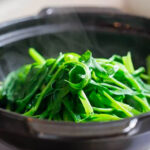Check out these discounted dish scrubbers now

However, when there is an adhesive residue on stainless steel, if you do not know how to handle it properly, it is easy to damage the surface of these items. So, let’s try these three methods to remove adhesive residues, especially sticker marks, on stainless steel cookware when they are new.
1Use oil for friction
To remove sticker marks, you can use oil to rub on the surface with the following steps:
Step 1: Remove the sticker by hand.
Before applying oil to the adhesive residue, use your hands to remove as much of the sticker as possible until nothing else comes off.

Step 2: Depending on the shape of the item with the sticker, when applying oil to the adhesive area, try not to let the oil spill out too much.

Step 3: Use a soft cloth to absorb a small amount of olive oil or any cooking oil, and use it to rub the adhesive surface.
- You can apply or spray oil directly onto the sticker and wait for about 3 minutes before rubbing it with a clean cloth.
- The time it takes for the oil to absorb depends on the size of the sticker and the strength of the glue, so you can wait 3 minutes or longer, or shorter, depending on your judgment.

Step 4: Use an oil-absorbent cloth to wipe away the glue on the surface, as it will remove the sticker and pull off the adhesive residue.

If there is still adhesive residue on the surface of the item, repeat the above steps.
Step 5: Use a cloth to wipe the entire surface of the material. The oil will help you remove fingerprints and other dirt easily.

2Use coconut oil and heat
Using coconut oil and heat is another way to help you remove the adhesive residue of stickers from products:
Step 1: Use a flame to heat the sticker.
You can use a flame to heat the sticker for about 30 seconds to heat the entire area where the sticker is attached. Don’t worry if you see black marks appear on the surface, as long as you don’t hold the flame in one place for too long.

Step 2: Remove the sticker.
After heating the sticker with the flame, the adhesive will melt and burn. At this point, you can peel off the sticker with your finger without much difficulty. If it feels hard to remove, heat it again.

Step 3: Clean the remaining residue with coconut oil.
You only need a few drops of coconut oil, spread it on the remaining adhesive with your finger. Then, you can use tissue paper or a soft cloth to wipe it off.

3Use alcohol
Additionally, you can use alcohol to remove sticker residue from cookware and other kitchen appliances as follows:
Step 1: Use a tissue paper soaked in alcohol and place it on the sticker.
When the alcohol transfers from the tissue to the sticker, it will start to dissolve the adhesive within a few minutes.

Step 2: Use the tissue to rub the sticker
After allowing the alcohol to loosen most of the adhesive, use the tissue to rub vigorously to help remove the adhesive quickly.

Step 3: Use your fingers to scrape off any remaining adhesive
Finally, use your fingers to remove any remaining adhesive residue. The alcohol will quickly remove the adhesive without damaging the shine or causing scratches on the cookware.

- Soak a corner of a soft cloth with vinegar and use it to wipe the surface of the item to remove oil residue (after performing the above methods).
- Then, use a clean cloth soaked in warm water to wipe the entire surface again. If you use a cloth soaked in oil and vinegar after performing the above step, make sure to rinse the cloth thoroughly with water.
- Finally, use a dry cloth to wipe the entire cookware.






































